An Adaptive Pedestrian Flow Prediction Model Based on First-Order Differential Error Adjustment and Hidden Markov Model
Abstract
1. Introduction
1.1. Time Series Forecasting
1.2. Problem Analysis and Research Questions
- Sensitivity to Zero Values and Discontinuities: Model performance deteriorates when the dataset contains a high proportion of zero values or when pedestrian flow patterns exhibit abrupt discontinuities, leading to instability in predictions.
- Limited Adaptability to Irregular Patterns: When pedestrian flow follows atypical periodic patterns, such as those observed during special events, unconventional holidays, or weekends, prediction accuracy remains low. The models lack the capability to dynamically adjust to real-time variations.
- Inadequate Handling of Environmental Changes: Existing methods struggle to effectively incorporate environmental dynamics, often resulting in substantial prediction errors [26].
- Is it possible to propose a novel method that enables the model to perform effectively in the presence of data discontinuity and an excessive proportion of zero values?
- Can an adaptive model tuning approach be developed to address the issue of environmental factor changes, which alter sequence characteristics and impact prediction accuracy in indoor pedestrian traffic forecasting?
- Can the two proposed improvements be integrated to enhance the overall accuracy of the model, ensuring its suitability for the specific application of indoor pedestrian flow prediction?
1.3. Article Structure
2. Related Work
2.1. Models for Pedestrian Flow Prediction (PFP)
2.2. Pedestrian Flow Prediction (PFP) with LSTM Model
2.3. Self-Adaptation and Self-Learning in Prediction
3. Methodology
3.1. Selection of Error-Adjusted LSTM
3.2. HMM-Based and Error-Adjusted LSTM
3.3. Evaluation Method
4. Experiments and Result Analysis
4.1. Data Collection
4.2. Traditional LSTM
4.3. Error-Adjusted LSTM
4.4. HMM-Fod-LSTM
- If the residual change (as shown in Equation (22)) is greater than or equal to the threshold , the time node is assigned to the “increase” state.
- If is less than or equal to the threshold , the time node belongs to the “decrease” state.
- If lies between and , the time node is categorized as the “unchanged” state.
- For the “increase” state, is multiplied by ;
- For the “decrease” state, is multiplied by ;
- In other cases, the predicted value remains unchanged.
- For thresholds , no time nodes belong to the “increasing” state, while 68 time nodes are classified as the “decreasing” state. When or , both and , evaluated based on the adjusted time nodes (not all predicted nodes), are 58.82%. When , and increase to 60.29%;
- For thresholds , no time nodes belong to the “increasing” state, while 54 time nodes are classified as the “decreasing” state. When or , and are both 57.41%. In contrast, when , and improve to 59.26%;
- For thresholds , no time nodes belong to the “increasing” state, and 14 time nodes are classified as the “decreasing” state. When or , both and are 42.86%. However, when , and increase to 50.00%;
- For thresholds no time nodes belong to the “increasing” state, and nine time nodes are classified as the “decreasing” state. In this case, and are independent of the adjustment coefficient and remain at 44.44%;
- For thresholds , no time nodes belong to the “increasing” state, while only one time node is classified as the “decreasing” state. Here, and are unaffected by , both registering as 0%.
5. Conclusions
Author Contributions
Funding
Data Availability Statement
Conflicts of Interest
References
- De Gooijer, J.G.; Hyndman, R.J. 25 years of time series forecasting. Int. J. Forecast. 2006, 22, 443–473. [Google Scholar] [CrossRef]
- Parzen, E. An approach to time series analysis. Ann. Math. Stat. 1961, 32, 951–989. [Google Scholar] [CrossRef]
- Sezer, O.B.; Gudelek, M.U.; Ozbayoglu, A.M. Financial time series forecasting with deep learning: A systematic literature review: 2005–2019. Appl. Soft Comput. 2020, 90, 106181. [Google Scholar] [CrossRef]
- Maleki, M.; Mahmoudi, M.R.; Wraith, D.; Pho, K.-H. Time series modelling to forecast the confirmed and recovered cases of COVID-19. Travel Med. Infect. Dis. 2020, 37, 101742. [Google Scholar] [CrossRef]
- Zhang, X.; Zhao, J.; Cai, B. Prediction Model with Dynamic Adjustment for Single Time Series of PM2.5. Acta Autom. Sin. 2018, 44, 1790–1798. [Google Scholar] [CrossRef]
- Li, L.; Su, X.; Zhang, Y.; Lin, Y.; Li, Z. Trend modeling for traffic time series analysis: An integrated study. IEEE Trans. Intell. Transp. Syst. 2015, 16, 3430–3439. [Google Scholar] [CrossRef]
- Liu, M.; Li, L.; Li, Q.; Bai, Y.; Hu, C. Pedestrian flow prediction in open public places using graph convolutional network. ISPRS Int. J. Geo-Inf. 2021, 10, 455. [Google Scholar] [CrossRef]
- Luca, M.; Barlacchi, G.; Lepri, B.; Pappalardo, L. Deep learning for human mobility a survey on data and models. arXiv 2020, arXiv:2012.02825. [Google Scholar]
- Deng, H.; Tian, M.; Ou, Z.; Deng, Y. A semantic framework for on-site evacuation routing based on awareness of obstacle accessibility. Autom. Constr. 2022, 136, 104154. [Google Scholar] [CrossRef]
- Kitagawa, G.; Gersch, W. A smoothness priors time-varying AR coefficient modeling of nonstationary covariance time series. IEEE Trans. Autom. Control. 1985, 30, 48–56. [Google Scholar] [CrossRef]
- Alim, M.; Ye, G.-H.; Guan, P.; Huang, D.-S.; Zhou, B.-S.; Wu, W. Comparison of ARIMA model and XGBoost model for prediction of human brucellosis in mainland China: A time-series study. BMJ Open 2020, 10, e039676. [Google Scholar] [CrossRef]
- Siami-Namini, S.; Tavakoli, N.; Namin, A.S. A comparison of ARIMA and LSTM in forecasting time series. In Proceedings of the 2018 17th IEEE International Conference on Machine Learning and Applications (ICMLA), Orlando, FL, USA, 17–20 December 2018; IEEE: Piscataway, NJ, USA, 2018; pp. 1394–1401. [Google Scholar]
- Song, X.; Liu, Y.; Xue, L.; Wang, J.; Zhang, J.; Wang, J.; Jiang, L.; Cheng, Z. Time-series well performance prediction based on Long Short-Term Memory (LSTM) neural network model. J. Pet. Sci. Eng. 2020, 186, 106682. [Google Scholar] [CrossRef]
- Siami-Namini, S.; Tavakoli, N.; Namin, A.S. The performance of LSTM and BiLSTM in forecasting time series. In Proceedings of the 2019 IEEE International Conference on Big Data (Big Data), Los Angeles, CA, USA, 9–12 December 2019; IEEE: Piscataway, NJ, USA, 2019; pp. 3285–3292. [Google Scholar]
- Gers, F.A.; Eck, D.; Schmidhuber, J. Applying LSTM to time series predictable through time-window approaches. In Neural Nets WIRN Vietri-01; Springer: London, UK, 2002; pp. 193–200. [Google Scholar]
- Greff, K.; Srivastava, R.K.; Koutník, J.; Steunebrink, B.R.; Schmidhuber, J. LSTM: A search space odyssey. IEEE Trans. Neural Netw. Learn. Syst. 2016, 28, 2222–2232. [Google Scholar] [CrossRef] [PubMed]
- Hochreiter, S.; Schmidhuber, J. Long Short-Term Memory. Neural Comput. 1997, 9, 1735–1780. [Google Scholar] [CrossRef] [PubMed]
- Satrio, C.B.A.; Darmawan, W.; Nadia, B.U.; Hanafiah, N. Time series analysis and forecasting of coronavirus disease in Indonesia using ARIMA model and PROPHET. Procedia Comput. Sci. 2021, 179, 524–532. [Google Scholar] [CrossRef]
- Samal, K.K.R.; Babu, K.S.; Das, S.K.; Acharaya, A. Time series based air pollution forecasting using SARIMA and prophet model. In Proceedings of the 2019 International Conference on Information Technology and Computer Communications, Guangzhou, China, 20–22 December 2019; pp. 80–85. [Google Scholar]
- Taylor, S.J.; Letham, B. Forecasting at scale. Am. Stat. 2018, 72, 37–45. [Google Scholar] [CrossRef]
- Alawad, H.; An, M.; Kaewunruen, S. Utilizing an adaptive neuro-fuzzy inference system (ANFIS) for overcrowding level risk assessment in railway stations. Appl. Sci. 2020, 10, 5156. [Google Scholar] [CrossRef]
- Du, B.; Peng, H.; Wang, S.; Alam Bhuiyan, Z.; Wang, L.; Gong, Q.; Liu, L.; Li, J. Deep irregular convolutional residual LSTM for urban traffic passenger flows prediction. IEEE Trans. Intell. Transp. Syst. 2019, 21, 972–985. [Google Scholar] [CrossRef]
- Fernandes, B.; Silva, F.; Alaiz-Moretón, H.; Novais, P.; Analide, C.; Neves, J. Traffic flow forecasting on data-scarce environments using ARIMA and LSTM networks. In Proceedings of the World Conference on Information Systems and Technologies, Galicia, Spain, 16–19 April 2019; Springer: Cham, Switzerland, 2019; pp. 273–282. [Google Scholar]
- Ma, C.; Dai, G.; Zhou, J. Short-term traffic flow prediction for urban road sections based on time series analysis and LSTM_BILSTM method. IEEE Trans. Intell. Transp. Syst. 2021, 23, 5615–5624. [Google Scholar] [CrossRef]
- Karimzadeh, M.; Aebi, R.; de Souza, A.M.; Zhao, Z.; Braun, T.; Sargento, S.; Villas, L. Reinforcement learning-designed LSTM for trajectory and traffic flow prediction. In Proceedings of the 2021 IEEE Wireless Communications and Networking Conference (WCNC), Nanjing, China, 29 March–1 April 2021; IEEE: Piscataway, NJ, USA, 2021; pp. 1–6. [Google Scholar]
- Manibardo, E.L.; Laña, I.; Del Ser, J. Change detection and adaptation strategies for long-term estimation of pedestrian flows. In Proceedings of the 2021 IEEE International Intelligent Transportation Systems Conference (ITSC), Indianapolis, IN, USA, 19–22 September 2021; IEEE: Piscataway, NJ, USA, 2021; pp. 1867–1874. [Google Scholar]
- Wang, D.-W.; Li, L.-N.; Hu, C.; Li, Q.; Chen, X.; Huang, P.-W. A modified inverse distance weighting method for interpolation in open public places based on Wi-Fi probe data. J. Adv. Transp. 2019, 2019, 1–11. [Google Scholar] [CrossRef]
- Lee, R.S.C.; Hughes, R.L. Prediction of human crowd pressures. Accid. Anal. Prev. 2006, 38, 712–722. [Google Scholar] [CrossRef] [PubMed]
- Yan, D.; Zhou, J.; Zhao, Y.; Wu, B. Short-term subway passenger flow prediction based on ARIMA. In Proceedings of the International Conference on Geo-Spatial Knowledge and Intelligence, Chiang Mai, Thailand, 8–10 December 2017; Springer: Singapore, 2017; pp. 464–479. [Google Scholar]
- Liu, D.; Rong, W.; Zhang, J.; Ge, Y.-E. Exploring the Nonlinear Effects of Built Environment on Bus-Transfer Ridership: Take Shanghai as an Example. Appl. Sci. 2022, 12, 5755. [Google Scholar] [CrossRef]
- Cohen, A.; Dalyot, S. Machine-learning prediction models for pedestrian traffic flow levels: Towards optimizing walking routes for blind pedestrians. Trans. GIS 2020, 24, 1264–1279. [Google Scholar] [CrossRef]
- Abrishami, S.; Kumar, P. Using real-world store data for foot traffic forecasting. In Proceedings of the 2018 IEEE International Conference on Big Data (Big Data), Seattle, WS, USA, 10–13 December 2018; IEEE: Piscataway, NJ, USA, 2018; pp. 1885–1890. [Google Scholar]
- Li, C.; Xu, P. Application on traffic flow prediction of machine learning in intelligent transportation. Neural Comput. Appl. 2021, 33, 613–624. [Google Scholar] [CrossRef]
- Essien, A.E.; Chukwkelu, G.; Giannetti, C. A scalable deep convolutional LSTM neural network for large-scale urban traffic flow prediction using recurrence plots. In Proceedings of the 2019 IEEE AFRICON, Accra, Ghana, 25–27 September 2019; IEEE: Piscataway, NJ, USA, 2019; pp. 1–7. [Google Scholar]
- Zhu, J.; Feng, F.; Shen, B. People counting and pedestrian flow statistics based on convolutional neural network and recurrent neural network. In Proceedings of the 2018 33rd Youth Academic Annual Conference of Chinese Association of Automation (YAC), Nanjing, China, 18–20 May 2018; IEEE: Piscataway, NJ, USA, 2018; pp. 993–998. [Google Scholar]
- Shaoji, W.U.; Yike, H.U. Research on Spatial Hyper-Links in Commercial Complexes Based on Deep Learning: A Case Study of TaiKoo Li Sanlitun and Beijing APM. South Archit. 2022, 1, 61–68. [Google Scholar]
- Al-Selwi, S.M.; Hassan, M.F.; Abdulkadir, S.J.; Muneer, A.; Sumiea, E.H.; Alqushaibi, A.; Ragab, M.G. RNN-LSTM: From applications to modeling techniques and beyond—Systematic review. J. King Saud Univ.—Comput. Inf. Sci. 2024, 36, 102068. [Google Scholar] [CrossRef]
- Badri, A.K.; Heikal, J.; Terah, Y.A.; Nurjaman, D.R. Decision-Making Techniques using LSTM on Antam Mining Shares before and during the COVID-19 Pandemic in Indonesia. APTISI Trans. Manag. (ATM) 2022, 6, 167–180. [Google Scholar] [CrossRef]
- Fan, D.; Sun, H.; Yao, J.; Zhang, K.; Yan, X.; Sun, Z. Well production forecasting based on ARIMA-LSTM model considering manual operations. Energy 2021, 220, 119708. [Google Scholar] [CrossRef]
- Yan, R.; Liao, J.; Yang, J.; Sun, W.; Nong, M.; Li, F. Multi-hour and multi-site air quality index forecasting in Beijing using CNN, LSTM, CNN-LSTM, and spatiotemporal clustering. Expert Syst. Appl. 2021, 169, 114513. [Google Scholar] [CrossRef]
- Yu, Y.; Si, X.; Hu, C.; Zhang, J. A review of recurrent neural networks: LSTM cells and network architectures. Neural Comput. 2019, 31, 1235–1270. [Google Scholar] [CrossRef]
- Staudemeyer, R.C.; Morris, E.R. Understanding LSTM—A tutorial into long short-term memory recurrent neural networks. arXiv 2019, arXiv:1909.09586. [Google Scholar]
- Wang, Y.; Yu, C.; Hou, J.; Chu, S.; Zhang, Y.; Zhu, Y. ARIMA Model and Few-Shot Learning for Vehicle Speed Time Series Analysis and Prediction. Comput. Intell. Neurosci. 2022, 2022, 2526821. [Google Scholar] [CrossRef]
- Zheng, H.; Liu, Y.; Wan, W.; Zhao, J.; Xie, G. Large-scale prediction of stream water quality using an interpretable deep learning approach. J. Environ. Manag. 2023, 331, 117309. [Google Scholar] [CrossRef] [PubMed]
- Chen, S.; Li, Q.; Zhou, T.; Lu, S. Multivariable Adaptive Control Algorithm of Variable Cycle Engine Based on Data Driven. J. Propuls. Technol. 2022, 43, 371–382. [Google Scholar] [CrossRef]
- Sivakumar, G. HMM-LSTM Fusion Model for Economic Forecasting[A/OL]. arXiv 2025, arXiv:2501.02002. [Google Scholar]
- Stepanyan, I.V.; Lednev, M.Y. Prediction of the trajectory of the tracking object based on adaptive controller. IOP Conf. Ser. Mater. Sci. Eng. 2020, 747, 12078. [Google Scholar] [CrossRef]
- Ma, C.; Zhu, X.; Han, Y. Application of Adaptive Generalized Predictive Control Based on PSO in Microturbines. Control Eng. China 2019, 26, 179–184. [Google Scholar]
- Mo, S. Model-Free Adaptive Predictive Control for Tracking the Dynamic Target Position of Vehicle. Mach. Des. Manuf. 2018, 12, 1296–1299. [Google Scholar] [CrossRef]
- Zeng, C.; Hua, C.; Lei, T.; Xiao, X. Short-term traffic flow prediction on campus based on modified PSOBP neural network. J. Phys. Conf. Ser. 2020, 1592, 012071. [Google Scholar] [CrossRef]
- Alahakoon, D.; Nawaratne, R.; Xu, Y.; De Silva, D.; Sivarajah, U.; Gupta, B. Self-building artificial intelligence and machine learning to empower big data analytics in smart cities. Inf. Syst. Front. 2020, 25, 221–240. [Google Scholar] [CrossRef]
- Zhang, T.; Yuan, J.; Chen, Y.-C.; Jia, W. Self-learning soft computing algorithms for prediction machines of estimating crowd density. Appl. Soft Comput. 2021, 105, 107240. [Google Scholar] [CrossRef]
- Zhou, Y.; Ravey, A.; Pera, M.C. A velocity prediction method based on self-learning multi-step Markov chain. In Proceedings of the IECON 2019-45th Annual Conference of the IEEE Industrial Electronics Society, Lisbon, Portugal, 14–17 October 2019; IEEE: Piscataway, NJ, USA, 2019; Volume 1, pp. 2598–2603. [Google Scholar]
- Tran, D.P.; Hoang, V.D. Adaptive learning based on tracking and ReIdentifying objects using convolutional neural network. Neural Process. Lett. 2019, 50, 263–282. [Google Scholar] [CrossRef]
- Goldhammer, M.; Kohler, S.; Doll, K.; Sick, B. Camera based pedestrian path prediction by means of polynomial least-squares approximation and multilayer perceptron neural networks. In Proceedings of the 2015 SAI Intelligent Systems Conference (IntelliSys), London, UK, 10–11 November 2015; IEEE: Piscataway, NJ, USA, 2015; pp. 390–399. [Google Scholar]
- George, S.; Santra, A.K. Traffic prediction using multifaceted techniques: A survey. Wirel. Pers. Commun. 2020, 115, 1047–1106. [Google Scholar] [CrossRef]
- Huynh, M.; Alaghband, G. Aol: Adaptive online learning for human trajectory prediction in dynamic video scenes. arXiv 2020, arXiv:2002.06666. [Google Scholar]
- Harrou, F.; Dairi, A.; Zeroual, A.; Sun, Y. Forecasting of Bicycle and Pedestrian Traffic Using Flexible and Efficient Hybrid Deep Learning Approach. Appl. Sci. 2022, 12, 4482. [Google Scholar] [CrossRef]
- Kabak, Ö.; Ülengin, F.; Aktaş, E.; Önsel, Ş.; Topcu, Y.I. Efficient shift scheduling in the retail sector through two-stage optimization. Eur. J. Oper. Res. 2008, 184, 76–90. [Google Scholar] [CrossRef]
- Vintr, T.; Yan, Z.; Eyisoy, K.; Kubiš, F.; Blaha, J.; Ulrich, J.; Swaminathan, C.S.; Molina, S.; Kucner, T.P.; Magnusson, M.; et al. Natural criteria for comparison of pedestrian flow forecasting models. In Proceedings of the 2020 IEEE/RSJ International Conference on Intelligent Robots and Systems (IROS), Detroit, MI, USA, 1–5 October 2023; IEEE: Piscataway, NJ, USA, 2020; pp. 11197–11204. [Google Scholar]
- Thejaswini, R.S.S.; Rajaraajeswari, S. A real-time traffic congestion-avoidance framework for smarter cities. AIP Conf. Proc. 2018, 2039, 020009. [Google Scholar]
- May, M.; Scheider, S.; Rösler, R.; Schulz, D.; Hecker, D. Pedestrian flow prediction in extensive road networks using biased observational data. In Proceedings of the 16th ACM SIGSPATIAL International Conference on Advances in Geographic Information System, Hamburg, Germany, 13–16 November 2023. [Google Scholar]
- Cryer, J.D.; Chan, K.S. Time Series Analysis: With Applications in R; Springer Science & Business Media: Berlin, Germany, 2008. [Google Scholar]
- Rajan, A.; Salgaonkar, A. Part of speech (PoS) tagging for Konkani language using HMM. In ICT Systems and Sustainability; Springer: Singapore, 2022; pp. 601–609. [Google Scholar]
- Anandika, A.; Mishra, S.P.; Das, M. Review on Usage of Hidden Markov Model in Natural Language Processing. In Intelligent and Cloud Computing; Springer: Singapore, 2021; pp. 415–423. [Google Scholar]
- Sharma, R.; Kumar, S.; Tsunoda, T.; Kumarevel, T.; Sharma, A. Single-stranded and double-stranded DNA-binding protein prediction using HMM profiles. Anal. Biochem. 2021, 612, 113954. [Google Scholar] [CrossRef]
- Guo, J.; Xing, S.; Luan, H.; Jia, Y. Prediction of time series traffic based on improved LSTM algorithm. J. Nanjing Univ. Inf. Sci. Technol. (Nat. Sci. Ed.) 2021, 13, 571–675. [Google Scholar] [CrossRef]
- Li, L.; Zhang, Q.; Zhao, J.; Mie, Y. Short-Term Traffic Flow Prediction Method of Different Periods Based on Improved CNN-LSTM. J. Appl. Sci. 2021, 39, 185–198. [Google Scholar]
- Meng, X.; Fu, H.; Peng, L.; Liu, G.; Yu, Y.; Wang, Z.; Chen, E. D-LSTM: Short-term road traffic speed prediction model based on GPS positioning data. IEEE Trans. Intell. Transp. Syst. 2020, 23, 2021–2030. [Google Scholar] [CrossRef]

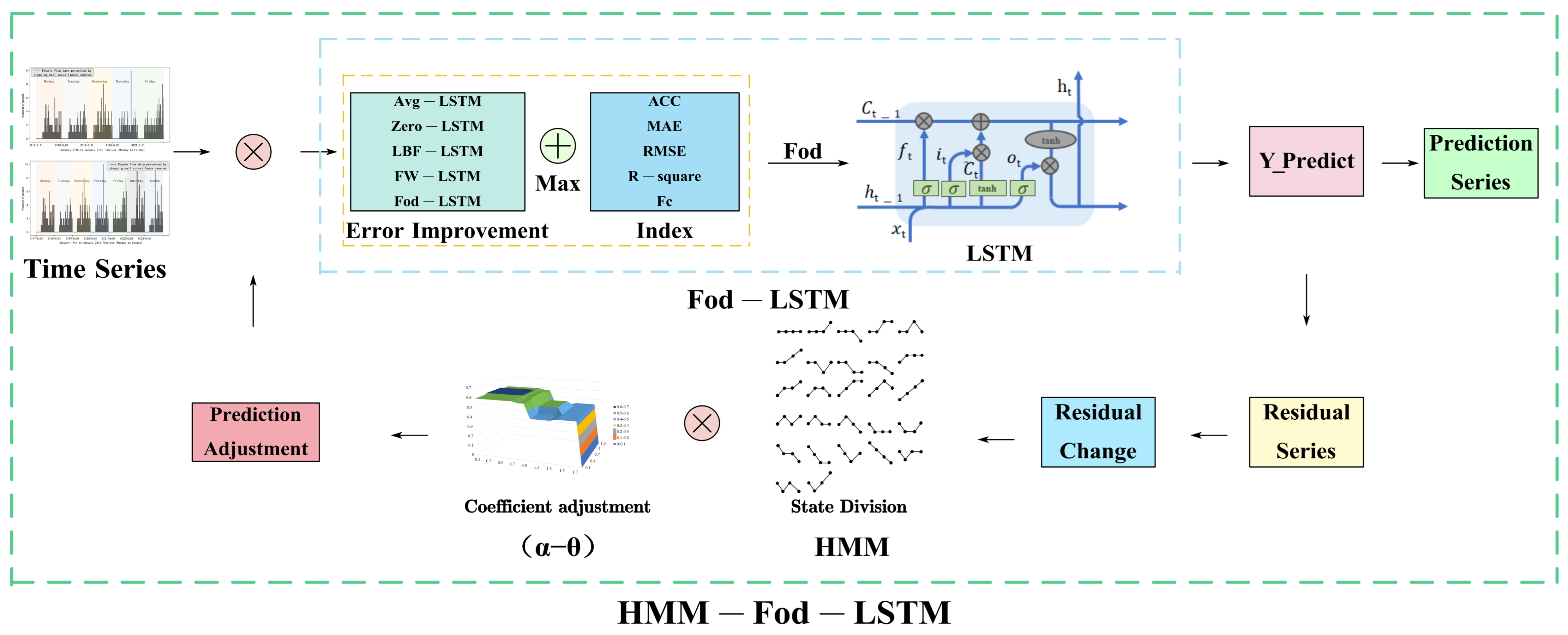
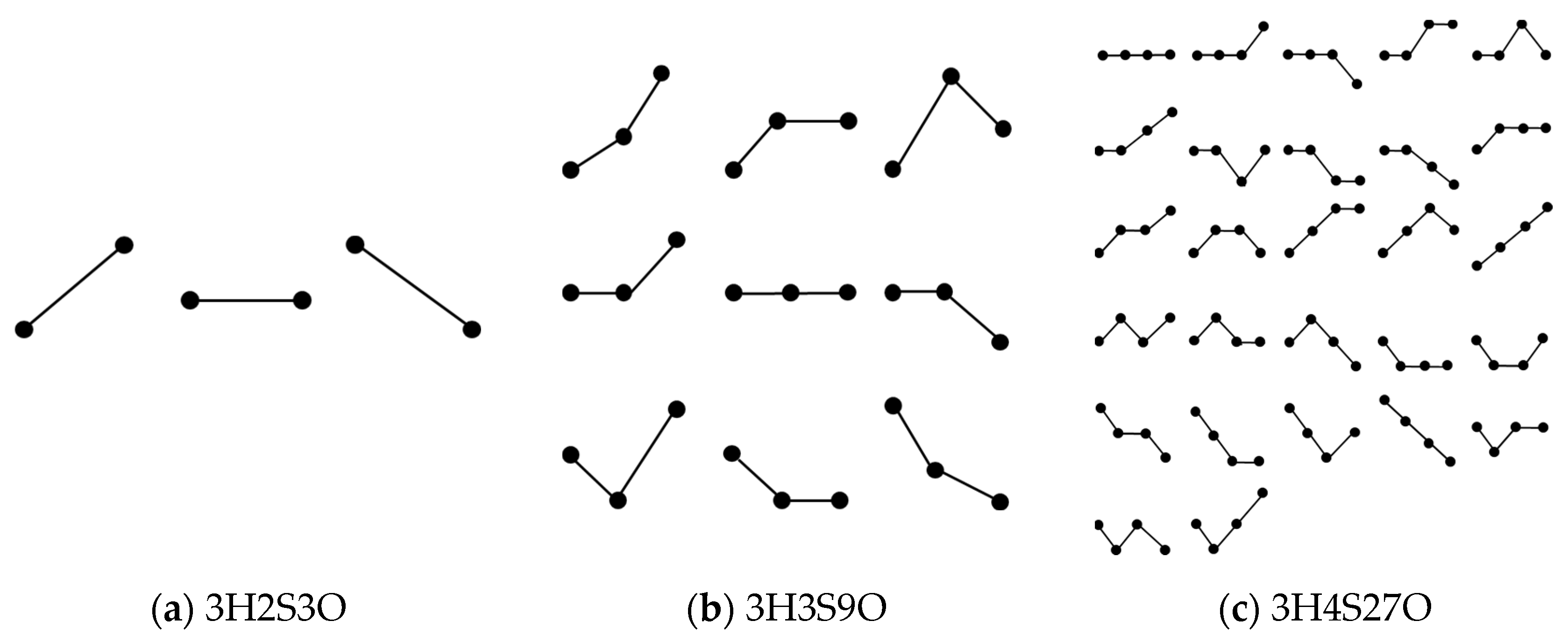
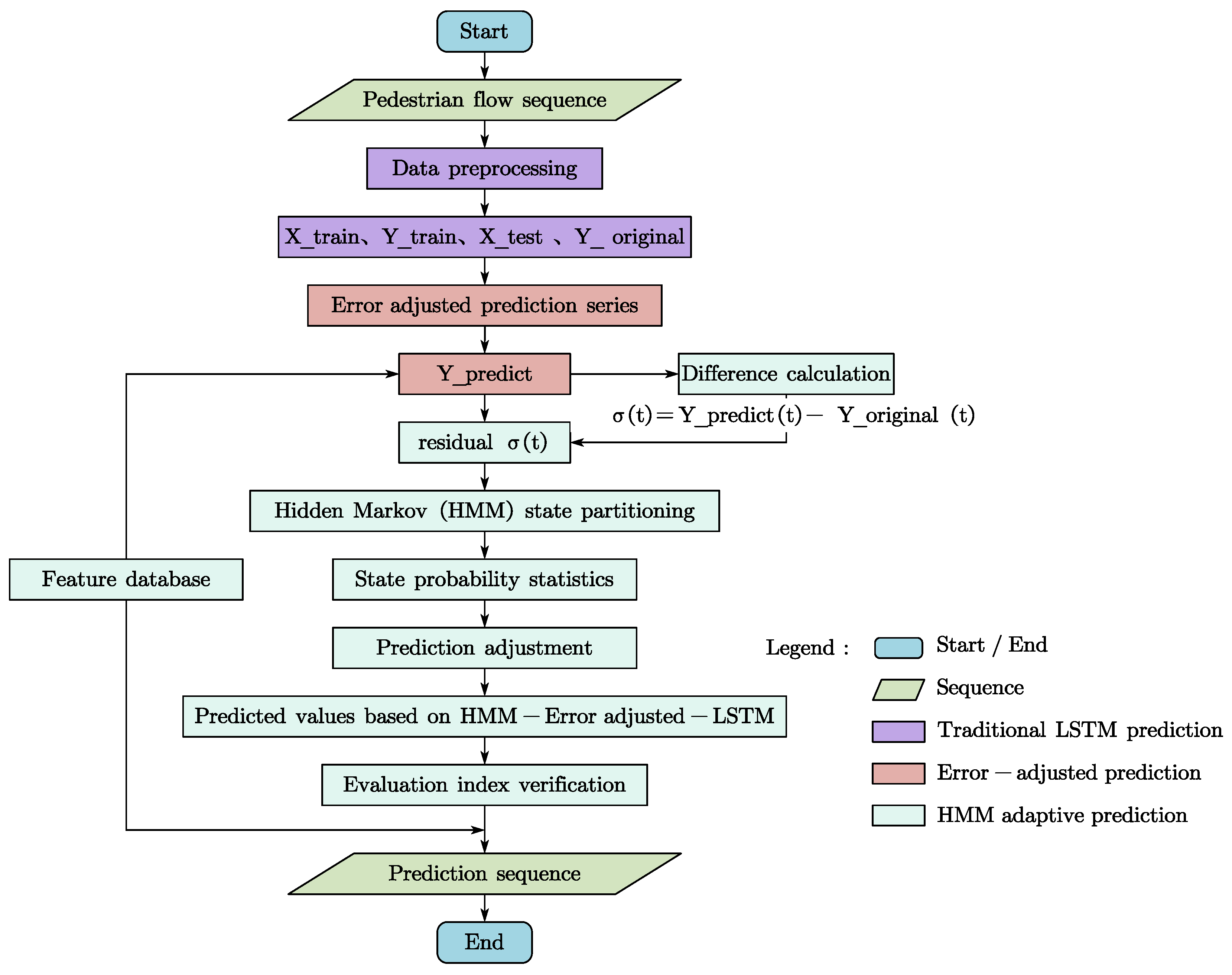


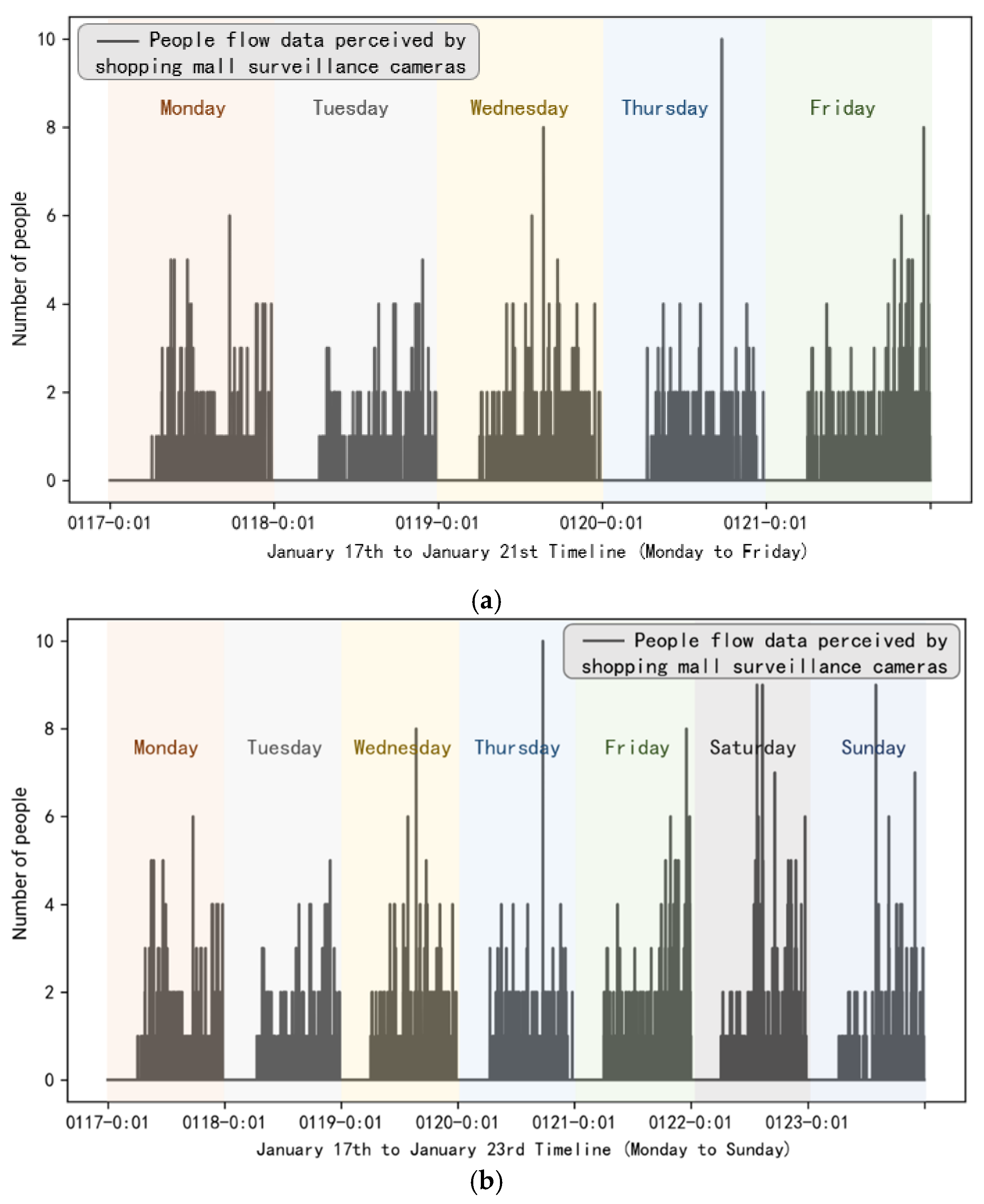




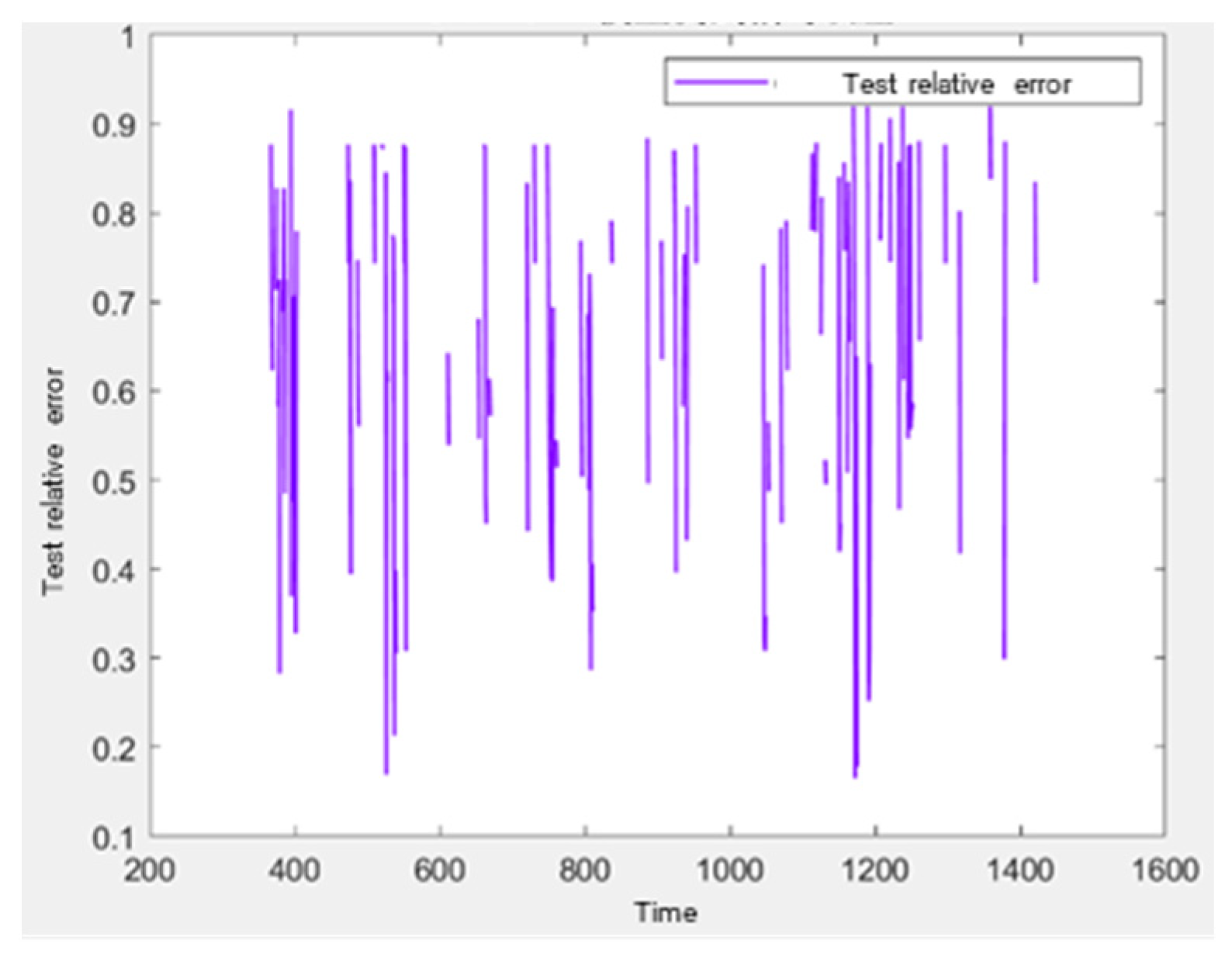
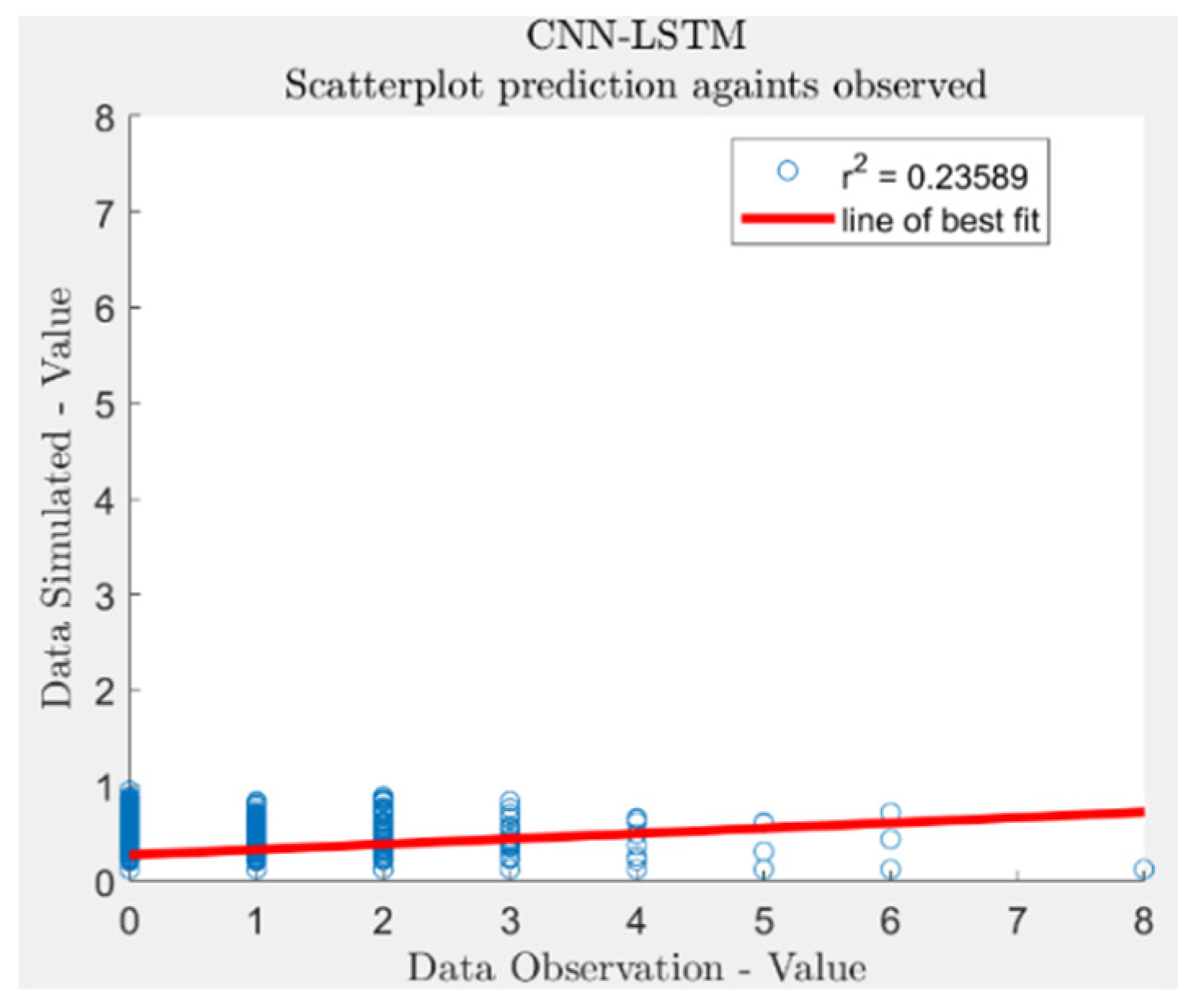
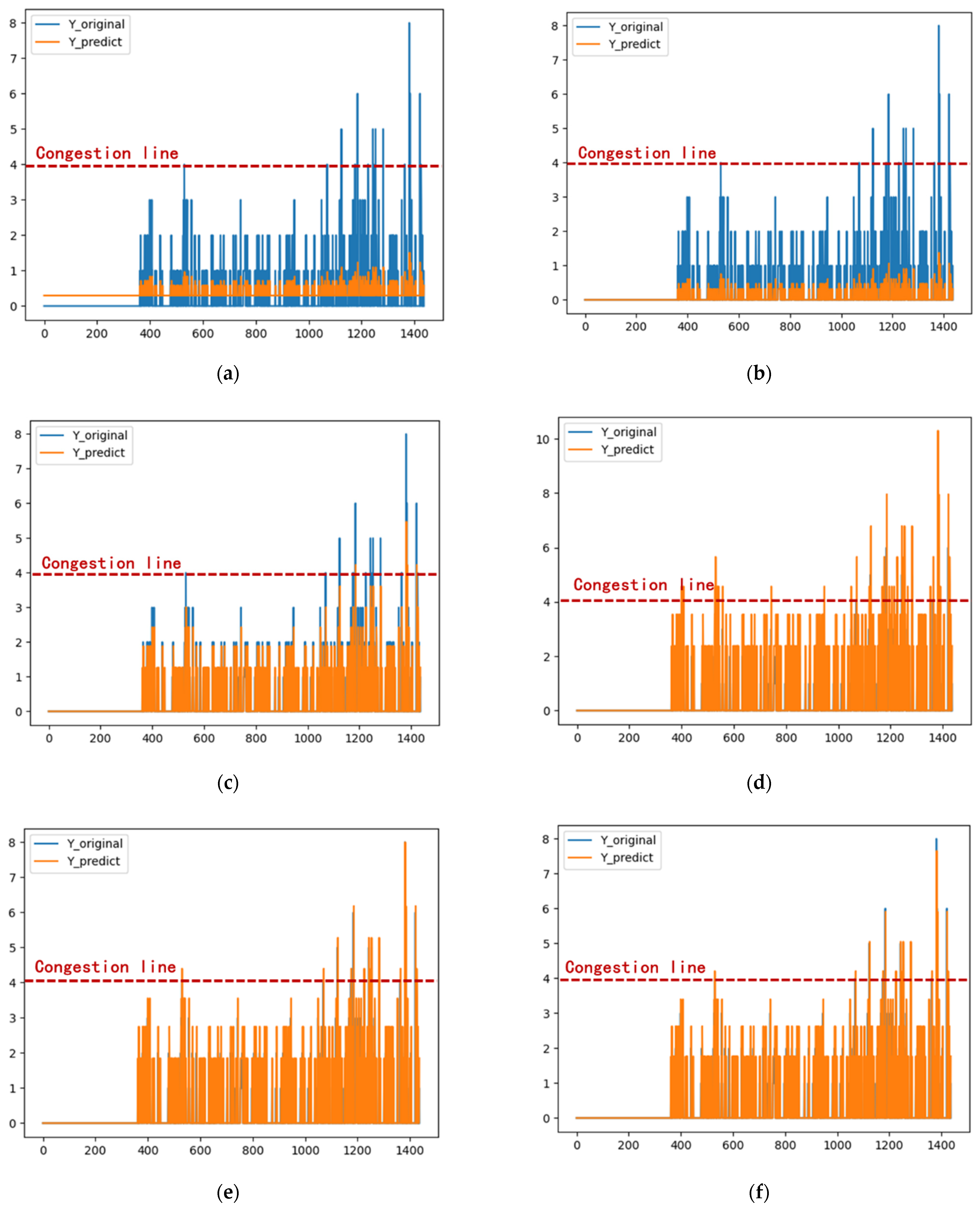
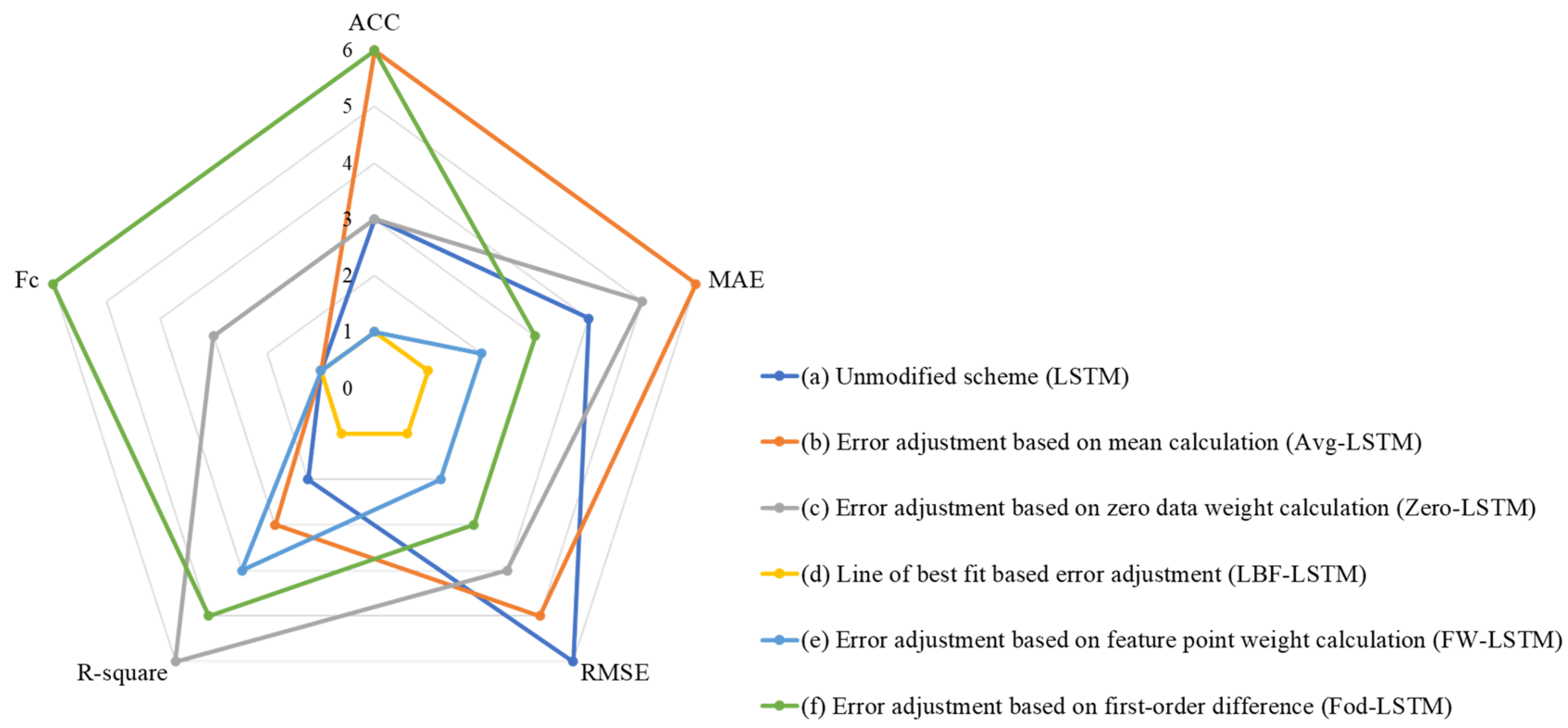


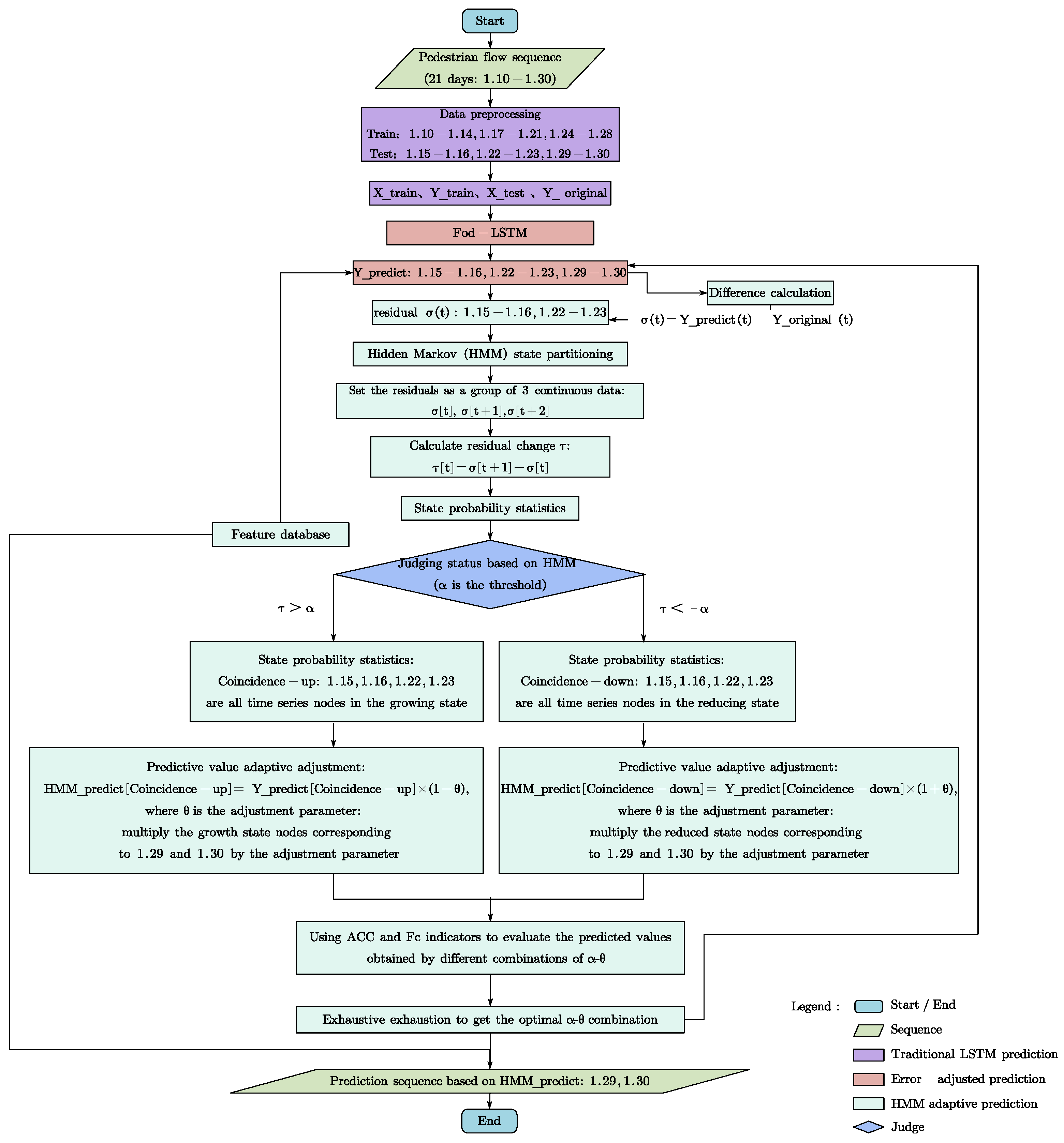
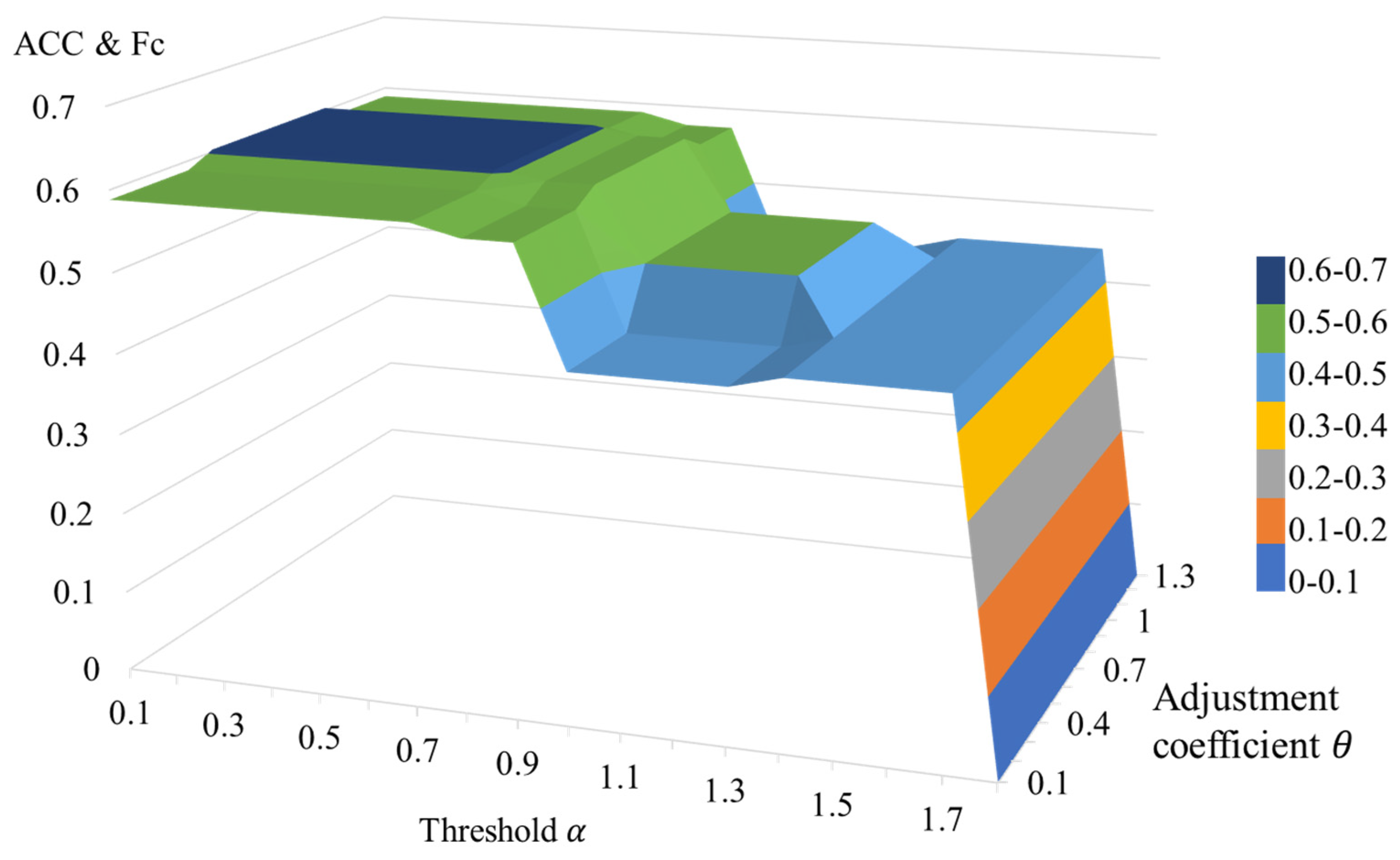
| Method | Task | Data Source | Reference | |
|---|---|---|---|---|
| Traditional statistical methods | AR | Comparing forecast accuracy at 5 min, 10 min, 25 min | 85 min of band performance | [28] |
| ARIMA | Predict passenger flow | Passenger flow recorded by 5 stations in eastern Guangzhou | [29] | |
| Machine learning model | XGBoost | The nonlinear effects of the built environment on bus interchange passenger flow are explored | Shanghai Metro Data | [30] |
| RF | Predict pedestrian traffic flow levels | Traffic data for POI such as public transport and shops | [31] | |
| Pedestrian flow prediction | Number of people in restaurants, bars, restaurants, and coffee shops | [32] | ||
| SVR | Pedestrian flow prediction and object tracking, pedestrian counting | Morning and evening peak traffic flow for a kilometer in California | [33] | |
| Deep learning model | LSTM | Traffic forecasting and efficient urban congestion management and future planning | Road traffic network data collected by sensors in California, USA | [34] |
| Pedestrian flow prediction | Number of people in restaurants, bars, restaurants, and coffee shops | [32] | ||
| CNN | People counting and pedestrian flow statistics | Pedestrian pictures | [35] | |
| Yolo-v3 | Achieve 3D spatial distribution prediction combined with people flow prediction | Taikoo Li Sanlitun site | [36] | |
| Propht | Pedestrian flow prediction | Number of people in restaurants, bars, restaurants, and coffee shops | [32] | |
| LSTM Structural Door | Schematic | Formula | |
|---|---|---|---|
| Forgotten gate |  | (1) | |
| Input gate | 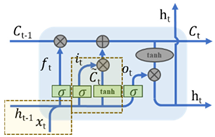 | (2) | |
| (3) | |||
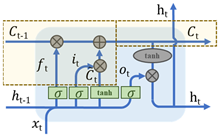 | (4) | ||
| Output gate |  | (5) | |
| (6) | |||
 | |||
| Method | Task | Reference |
|---|---|---|
| Particle swarm optimization algorithm (PSO) + BP neural network | Short-term traffic flow forecast on campus | [50] |
| Growing Self-Organizing Map (GSOM) | Big data analysis of people flow in smart city | [51] |
| Crowd density prediction machines via self-learning generative adversarial network | Crowd density prediction in non-real-time state | [52] |
| Traditional Markov + Multi-step Markov Chain | Prediction in various driving scenarios | [53] |
| PDnet + Adaptive CNN | track and re-identify objects | [54] |
| Polynomial least-squares approximation + Multilayer perceptron neural networks | Pedestrian path prediction | [55] |
| Machine Learning (ML) + Computational Intelligence (CI) + Deep Learning (DL) + Hybrid algorithms | Road traffic flow forecast | [56] |
| LSTM + Future Person Location (FPL) + Least recently used (LRU) strategy | Predict human movement trajectories in dynamic video scenes | [57] |
| Index | Formula | Evaluation Criteria | |
|---|---|---|---|
| Accuracy | (13) | Reflects the accuracy of the prediction, the higher the value, the higher the accuracy of the model | |
| Mean Absolute Error | (14) | Reflects the actual situation of the error of the predicted value. The smaller the value, the higher the accuracy of the model | |
| Root Mean Square Error | (15) | That is, the standard error, the smaller the value, the higher the accuracy of the model | |
| R-square | (16) | The closer the value is to 1, the higher the accuracy of the model | |
| (17) | |||
| (18) | |||
| F-crowded | (19) | The closer the value is to 1, the better the function of the model is | |
| Parameter | Value |
|---|---|
| epochs | 100 |
| batch_size | 1 |
| verbose | 2 |
| timestep | 1 |
| input_shape | None, 1 |
| feature_range | (0, 1) |
| dataset.reshape | (−1, 1) |
| train:test | 4:1 |
| Scheme | ACC | MAE | RMSE | R-square | Fc |
|---|---|---|---|---|---|
| (a) | 0.7121 | 0.5236 | 0.7906 | 0.0418 | 0.0000 |
| (b) | 0.7885 | 0.3489 | 0.8268 | 0.1421 | 0.0000 |
| (c) | 0.7058 | 0.4737 | 0.9824 | 0.7933 | 0.2353 |
| (d) | 0.6787 | 0.7282 | 1.4749 | 2.9375 | 2.1765 |
| (e) | 0.6808 | 0.6007 | 1.2167 | 1.7303 | 2.1765 |
| (f) | 0.7815 | 0.5826 | 1.1808 | 1.5776 | 1.0000 |
| Scheme | Data | ACC | MAE | RMSE | R-Square | Fc |
|---|---|---|---|---|---|---|
| LSTM | 1.10–1.14 | 0.8059 | 0.4012 | 0.6121 | 0.0359 | 0.0000 |
| 1.17–1.21 | 0.7121 | 0.5236 | 0.7906 | 0.0418 | 0.0000 | |
| 1.24–1.28 | 0.7496 | 0.3354 | 0.6634 | 0.0399 | 0.0000 | |
| 1.31–2.4 | 0.8546 | 0.2427 | 0.4763 | 0.0276 | 0.0000 | |
| Fod-LSTM | 1.10–1.14 | 0.7476 | 0.3381 | 0.7618 | 0.7085 | 1.0000 |
| 1.17–1.21 | 0.7815 | 0.5826 | 1.1808 | 1.5776 | 1.0000 | |
| 1.24–1.28 | 0.8219 | 0.4666 | 1.0383 | 1.9931 | 0.5000 | |
| 1.31–2.4 | 0.9172 | 0.3104 | 0.9085 | 2.9880 | 0.7143 |
| Data | ACC | MAE | RMSE | R-Square | Fc |
|---|---|---|---|---|---|
| 1.10–1.16 | 0.7926 | 0.2807 | 0.7649 | 0.5786 | 0.4444 |
| 1.17–1.23 | 0.7605 | 0.6396 | 1.5164 | 3.9356 | 1.7000 |
| 1.24–1.30 | 0.7644 | 0.4086 | 0.9575 | 1.4022 | 0.8518 |
| 1.31–2.6 | 0.8454 | 0.3392 | 0.9629 | 2.8277 | 1.0000 |
Disclaimer/Publisher’s Note: The statements, opinions and data contained in all publications are solely those of the individual author(s) and contributor(s) and not of MDPI and/or the editor(s). MDPI and/or the editor(s) disclaim responsibility for any injury to people or property resulting from any ideas, methods, instructions or products referred to in the content. |
© 2025 by the authors. Licensee MDPI, Basel, Switzerland. This article is an open access article distributed under the terms and conditions of the Creative Commons Attribution (CC BY) license (https://creativecommons.org/licenses/by/4.0/).
Share and Cite
Zhang, H.; Deng, J.; Xu, Y.; Deng, Y.; Lin, J.-R. An Adaptive Pedestrian Flow Prediction Model Based on First-Order Differential Error Adjustment and Hidden Markov Model. Buildings 2025, 15, 902. https://doi.org/10.3390/buildings15060902
Zhang H, Deng J, Xu Y, Deng Y, Lin J-R. An Adaptive Pedestrian Flow Prediction Model Based on First-Order Differential Error Adjustment and Hidden Markov Model. Buildings. 2025; 15(6):902. https://doi.org/10.3390/buildings15060902
Chicago/Turabian StyleZhang, Hengyun, Jianyi Deng, Yiwen Xu, Yichuan Deng, and Jia-Rui Lin. 2025. "An Adaptive Pedestrian Flow Prediction Model Based on First-Order Differential Error Adjustment and Hidden Markov Model" Buildings 15, no. 6: 902. https://doi.org/10.3390/buildings15060902
APA StyleZhang, H., Deng, J., Xu, Y., Deng, Y., & Lin, J.-R. (2025). An Adaptive Pedestrian Flow Prediction Model Based on First-Order Differential Error Adjustment and Hidden Markov Model. Buildings, 15(6), 902. https://doi.org/10.3390/buildings15060902








